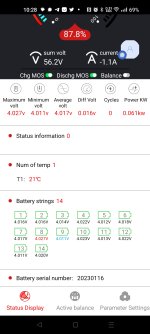My Monstrous Beast (14S10P, 140 Samsung 18650 26j cells) pack is back in actions and sufficiently reinforced and shrink wrapped I do believe.
(14S10P, 140 Samsung 18650 26j cells) pack is back in actions and sufficiently reinforced and shrink wrapped I do believe.
Now I'm trying to get the settings on my Daly Smart BMS dialed.
I can set the active balancing current anywhere from 0.050ma to 1a and it can be set to start balancing at any voltage from 2.75v - 4.2v
The cells charged at pretty sporadic rates the first charge and I had set the balancing activation at 3.6v initially for that reason. After a gentle discharge cycle and then putting it back on the charger the cells all charge at identical rates and the balancing hasn't even kicked in once... Screenshot of the typical voltage difference between cells below if it matter.
I'm assuming it was just the fact that the cells were brand new from manufacturer/never been discharged or charged and we're also 5 years old based on manufacturing date. Had to break them in or something?
Cheers!

Now I'm trying to get the settings on my Daly Smart BMS dialed.
I can set the active balancing current anywhere from 0.050ma to 1a and it can be set to start balancing at any voltage from 2.75v - 4.2v
The cells charged at pretty sporadic rates the first charge and I had set the balancing activation at 3.6v initially for that reason. After a gentle discharge cycle and then putting it back on the charger the cells all charge at identical rates and the balancing hasn't even kicked in once... Screenshot of the typical voltage difference between cells below if it matter.
I'm assuming it was just the fact that the cells were brand new from manufacturer/never been discharged or charged and we're also 5 years old based on manufacturing date. Had to break them in or something?
Cheers!

Last edited:

